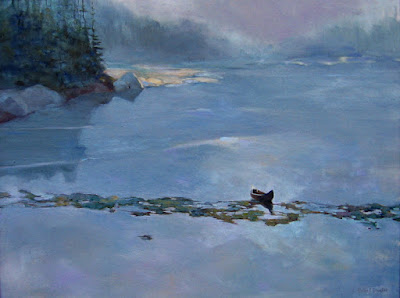Tricks to get myself moving when the body says ‘I want a nap.’
 |
| Striping, by Carol L. Douglas |
I felt fine when I got home from Scotland. Two days later, I wasn’t so sure, and I spent most of our lovely holiday weekend in a lawn chair with a book (except when canoeing, of course). This week, I ran an errand to Bangor with a painting student. By the time we came home, he was concerned enough to suggest that maybe he should drive.
I can’t decide if I’m suffering from a cold, allergies, fatigue or the ennui that sometimes settles in when I’m shifting gears and restless. The barrier between our mind and our bodies is whisper-thin. Like many Americans, I’m so trained to keep moving that it’s hard to recognize when I’m sick.
 |
| Parrsboro sunrise, by Carol L. Douglas |
The only way I can tell is by testing my body. Over the years I’ve developed strategies for catapulting myself out of a fog. Most important is routine. Every morning I write this blog, make my bed (so I can’t crawl back into it) and fold clothes. These tasks wake me up. Then I go down to my studio. My brain and body are conditioned to start concentrating at the same time every day.
I cannot overstress the importance of this; it’s why your lawyer, doctor, and insurance adjustor don’t have anxiety attacks every time they approach their desks. The human body loves settled routine, and thrives on regular sleep, exercise and work habits.
| Tricky Mary in a Pea-Soup Fog, by Carol L. Douglas |
My mother believed you would start moving if you heard a machine working, so she would start a load of laundry while she drank her morning coffee. I’m afraid it doesn’t work for me, but it might for you.
Often what stops me is not knowing where to start. To overcome that, I play a game of “put ten things away.” This is win-win, because you’re either going to force yourself back into motion or you’re going to have a very neat workspace. Ten is about my limit for being thoughtful about sorting, and it’s better than making a commitment to clean.
Water is our bodies’ principal component. It comprises about 60 percent of our body weight. We can live a surprisingly long time without food, but not without water. Fatigue can be caused by dehydration. None of us drink enough fluids when traveling, so when I come back from being on the road, I try to bring up my water intake as quickly as possible.
| Marsh, by Carol L. Douglas |
Current wisdom says that the basic equation for determining how much water you need is to divide your body weight in half. So, if you weigh 200 pounds, you would need 100 ounces of water per day. (I don’t know if this is scientifically justified.) When I drink that much, I never have the luxury of zoning out; I’m always planning my next toilet stop.
My last mental jog is a brisk walk. Exercise is a proven anti-depressant and makes us more alert. Walking also gives me the mental space to plan out my next steps.
What if I do all these things and I still don’t feel up to working? That’s a vivid warning sign that what I’m feeling isn’t temporary malaise but a true physical problem. I do what any sensible person would: I take some time off to recover.
What works to get you out of the doldrums?




